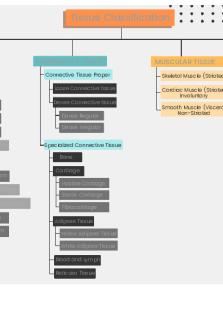Loose Connective Tissues PDF

| Title | Loose Connective Tissues |
|---|---|
| Course | Human Anatomy and Physiology with Lab I |
| Institution | The University of Texas at Dallas |
| Pages | 2 |
| File Size | 48.4 KB |
| File Type | |
| Total Downloads | 23 |
| Total Views | 132 |
Summary
Loose Connective Tissues...
Description
Loose Connective Tissues Loose connective tissues are the “packing materials” of the body. They fill spaces between organs, cushion and stabilize specialized cells in many organs, and support epithelia. These tissues surround and support blood vessels and nerves, store lipids, and provide a route for the diffusion of materials. Loose connective tissues include mucous connective tissue in embryos and areolar tissue, adipose tissue, and reticular tissue in adults. Embryonic Connective Tissues Mesenchyme (MEZ-en-kı . m), or embryonic connective tissue, is the first connective tissue to appear in a developing embryo. Mesenchyme contains an abundance of star-shaped stem cells (mesenchymal cells) separated by a matrix with very fine protein filaments (Figure 4–10a). Mesenchyme gives rise to all other connective tissues. Mucous connective tissue (Figure 4–10b), or Wharton’s jelly, is a loose connective tissue found in many parts of the embryo, including the umbilical cord. Adults have neither form of embryonic connective tissue. Instead, many adult connective tissues contain scattered mesenchymal stem cells that can assist in tissue repair after an injury. Areolar Tissue Areolar tissue (areola, little space) is the least specialized connective tissue in adults. It may contain all the cells and fibers of any connective tissue proper in a very loosely organized array (Figure 4–11a). Areolar tissue has an open framework. A viscous ground substance provides most of its volume and absorbs shocks. Areolar tissue can distort without damage because its fibers are loosely organized. Elastic fibers make it resilient, so areolar tissue returns to its original shape after external pressure is relieved. Areolar tissue forms a layer that separates the skin from deeper structures. In addition to providing padding, the elastic properties of this layer allow a considerable amount of independent movement. For this reason, if you pinch the skin of your arm, you will not affect the underlying muscle. Conversely, contractions of the underlying muscle do not pull against your skin: As the muscle bulges, the areolar tissue stretches. The
areolar tissue layer under the skin is a common injection site for drugs because it has an extensive blood supply. The capillaries (thin-walled blood vessels) in areolar tissue deliver oxygen and nutrients and remove carbon dioxide and waste products. They also carry wandering cells to and from the tissue. Epithelia commonly cover areolar tissue, and fibrocytes maintain the reticular lamina of the basement membrane that separates the two kinds of tissue. The epithelial cells rely on the oxygen and nutrients that diffuse across the basement membrane from capillaries in the underlying connective tissue....
Similar Free PDFs

Loose Connective Tissues
- 2 Pages

Loose Change - Karakter: 10
- 2 Pages

Connective tissue lab
- 3 Pages

Connective Tissue Table
- 1 Pages

Connective Tissue Chart
- 2 Pages

Lab 4- Connective Tissue
- 7 Pages

Connective Tissue Summary Table
- 3 Pages

Connective Tissue Reinforcement
- 1 Pages

Worksheet - tissues chart
- 1 Pages

Tissues Worksheet ADAupdated
- 7 Pages
Popular Institutions
- Tinajero National High School - Annex
- Politeknik Caltex Riau
- Yokohama City University
- SGT University
- University of Al-Qadisiyah
- Divine Word College of Vigan
- Techniek College Rotterdam
- Universidade de Santiago
- Universiti Teknologi MARA Cawangan Johor Kampus Pasir Gudang
- Poltekkes Kemenkes Yogyakarta
- Baguio City National High School
- Colegio san marcos
- preparatoria uno
- Centro de Bachillerato Tecnológico Industrial y de Servicios No. 107
- Dalian Maritime University
- Quang Trung Secondary School
- Colegio Tecnológico en Informática
- Corporación Regional de Educación Superior
- Grupo CEDVA
- Dar Al Uloom University
- Centro de Estudios Preuniversitarios de la Universidad Nacional de Ingeniería
- 上智大学
- Aakash International School, Nuna Majara
- San Felipe Neri Catholic School
- Kang Chiao International School - New Taipei City
- Misamis Occidental National High School
- Institución Educativa Escuela Normal Juan Ladrilleros
- Kolehiyo ng Pantukan
- Batanes State College
- Instituto Continental
- Sekolah Menengah Kejuruan Kesehatan Kaltara (Tarakan)
- Colegio de La Inmaculada Concepcion - Cebu





